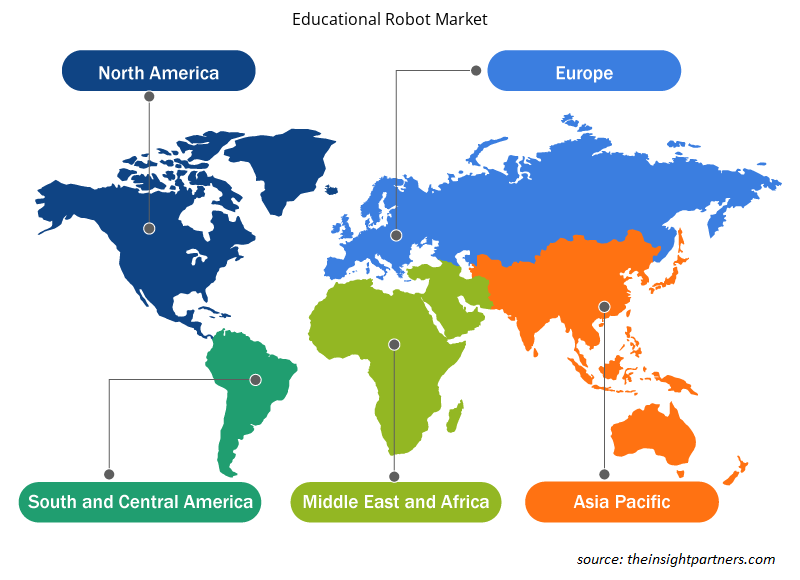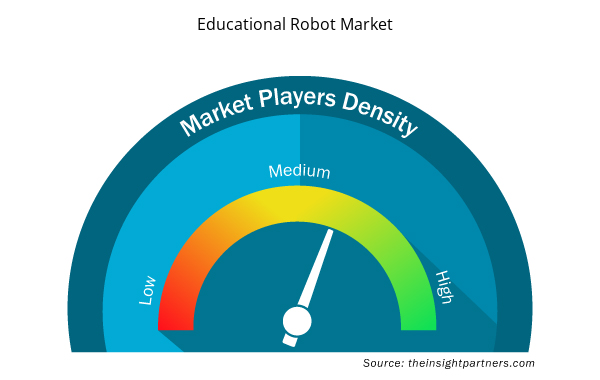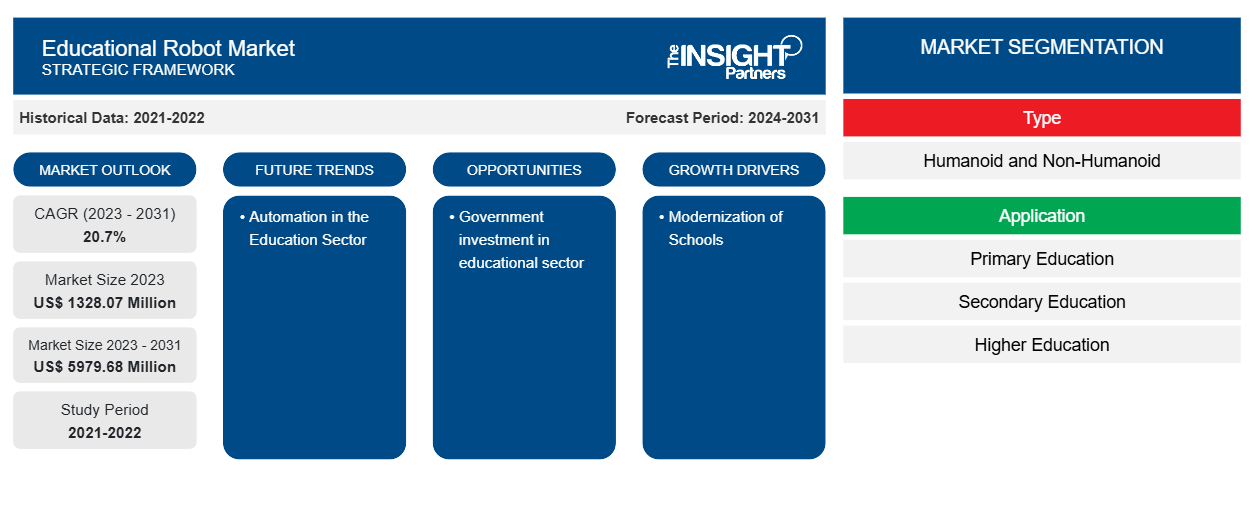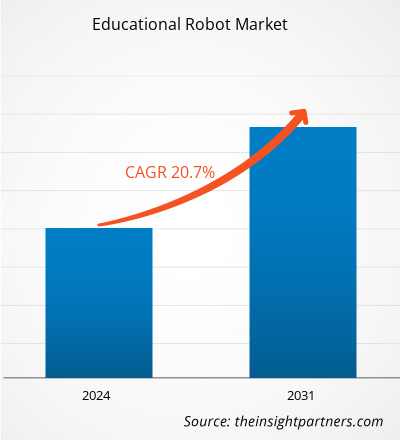教育用ロボット市場は、2023年の13億2,807万米ドルから2031年には59億7,968万米ドルに達すると予測されています。市場は2023年から2031年の間に20.7%のCAGRを記録すると予想されています。教育分野におけるロボット工学と自動化への政府投資は、今後も市場の主要なトレンドであり続けると思われます。
教育用ロボット市場分析
科学、技術、工学、数学 (STEM) の強化への注目が高まっていることが、市場の成長を牽引しています。政府当局による教育システムへの投資が、市場の成長をさらに促進しています。学校や大学では、ロボット工学のさまざまな側面を取り入れており、これが市場の成長を牽引しています。
教育用ロボット市場の概要
教育用ロボットは、あらゆる年齢の生徒がロボット工学とプログラミングの知識を深めることができるプログラム可能なロボットです。さらに、他の認知スキルの習得にも役立ちます。さまざまなタスクを実行できるロボットを構築およびプログラムするために必要なものがすべて生徒に提供されます。
要件に合わせてレポートをカスタマイズする
このレポートの一部、国レベルの分析、Excelデータパックなど、あらゆるレポートを無料でカスタマイズできます。また、スタートアップや大学向けのお得なオファーや割引もご利用いただけます。
- このレポートの主要な市場動向を入手してください。この無料サンプルには、市場動向から見積もりや予測に至るまでのデータ分析が含まれます。
教育用ロボット市場の推進要因と機会
学校の近代化
政府は、学校や大学の近代化と学生の学習のさらなる強化のため、教育分野に多額の投資を行っています。これらの投資により、市場プレーヤーは学校に教育用ロボットを提供することが奨励され、市場の成長を牽引しています。たとえば、2022年4月、デンマークのShape Roboticsは、ルーマニアの学校に教育用ロボットを配布するために、地元の同業KUBO Robotsと契約を締結したと発表しました。
教育分野における自動化
ABB が 2,301 人の教育専門家を対象に 2023 年に実施した世界規模の調査では、80% がロボットと自動化が今後 10 年間の雇用の未来を形作ると考えていることが明らかになりました。教育システムと教育プログラムにおけるロボットの使用。産業用ロボット市場のプレーヤーは、将来的に教育用ロボット市場を活性化できる教育分野でのロボットの導入に注力しています。
教育用ロボット市場レポートのセグメンテーション分析
教育用ロボット市場分析の導出に貢献した主要なセグメントは、タイプとアプリケーションです。
- 教育用ロボット市場は、タイプに基づいてヒューマノイドと非ヒューマノイドに分類されます。2023年には、非ヒューマノイドセグメントが市場で最大のシェアを占めました。
- アプリケーション別に見ると、市場は初等教育、中等教育、高等教育、その他に分類されます。その他のセグメントは、2023 年に市場の大きなシェアを占めました。
教育用ロボットの地域別市場シェア分析
教育用ロボット市場レポートの地理的範囲は、主に北米、アジア太平洋、ヨーロッパ、中東およびアフリカ、南米および中米の 5 つの地域に分かれています。
アジア太平洋地域は、予測期間中に最高のCAGRで成長すると予想されています。この地域は、教育分野の技術進歩に焦点を当てています。教育分野への投資の増加は、市場の成長を補完します。学校でのロボットの導入は、この地域の市場成長をさらに促進します。たとえば、2024年3月、ケララ州の学校は、教育に向けて革新的な一歩を踏み出すために、国内初のAI教師であるIrisを導入しました。IrisはMakerlabs Edutechとの提携により作成され、州で、そしておそらく国内初のヒューマノイドロボット教師です。Irisは、さまざまな科目にわたる複雑な質問に答え、個別の音声サポートを提供し、インタラクティブな教育機会を促進することができます。さらに、Irisには移動性を高めるために車輪が装備されています。
教育用ロボット市場の地域別分析
予測期間を通じて教育用ロボット市場に影響を与える地域的な傾向と要因は、Insight Partners のアナリストによって徹底的に説明されています。このセクションでは、北米、ヨーロッパ、アジア太平洋、中東およびアフリカ、南米および中米にわたる教育用ロボット市場のセグメントと地理についても説明します。

- 教育用ロボット市場の地域別データを入手
教育用ロボット市場レポートの範囲
| レポート属性 | 詳細 |
|---|---|
| 2023年の市場規模 | 13億2,807万米ドル |
| 2031年までの市場規模 | 59億7,968万米ドル |
| 世界のCAGR(2023年~2031年) | 20.7% |
| 履歴データ | 2021-2022 |
| 予測期間 | 2024-2031 |
| 対象セグメント | タイプ別
|
| 対象地域と国 | 北米
|
| 市場リーダーと主要企業プロフィール |
|
教育用ロボット市場のプレーヤー密度:ビジネスダイナミクスへの影響を理解する
教育用ロボット市場は、消費者の嗜好の変化、技術の進歩、製品の利点に対する認識の高まりなどの要因により、エンドユーザーの需要が高まり、急速に成長しています。需要が高まるにつれて、企業は提供を拡大し、消費者のニーズを満たすために革新し、新たなトレンドを活用し、市場の成長をさらに促進しています。
市場プレーヤー密度とは、特定の市場または業界内で活動している企業または会社の分布を指します。これは、特定の市場スペースに、その市場規模または総市場価値に対してどれだけの競合相手 (市場プレーヤー) が存在するかを示します。
教育用ロボット市場で活動している主要企業は次のとおりです。
- アイソイロボティクス
- ハンソン・ロボティクス・リミテッド
- モジュラーロボット
- PALロボティクス
- ファナックアメリカ株式会社
- サンボットイノベーションテクノロジー株式会社
免責事項:上記の企業は、特定の順序でランク付けされていません。

- 教育用ロボット市場のトップキープレーヤーの概要を入手
教育用ロボット市場のニュースと最近の動向
教育用ロボット市場は、主要な企業出版物、協会データ、データベースなどの一次および二次調査後の定性的および定量的データを収集することによって評価されます。教育用ロボット市場の動向のいくつかを以下に示します。
- ABB ロボティクスは、IRB 1090 の発売により教育サービスを拡大しました。世界的に認められた教育機関 STEM.org によって認定された 1090 産業教育ロボットは、学生のスキルを向上させ、就職における競争上の優位性を提供するように設計されています。この新しい教育ロボットは、追加の産業用ロボット、教育パッケージ、次世代コントローラー、市場をリードするプログラミングおよびシミュレーション ソフトウェアを含む、ABB の幅広い教育サービスの重要な部分を形成します。(出典: ABB ロボティクス、プレスリリース、2023 年 9 月)
- 革新性と独創性を核とするデジタル学習ソリューションプロバイダーである MatataStudio は、コンピューターサイエンス、人工知能、教育をエンターテイメントに融合することを目指した新しい教育用ロボットキット「VinciBot」を発売しました。小学校の教室には、AI や機械学習 (ML) などのハイテクコンセプトが導入されています。これらのロボットキットは、教育性が高いだけでなく、プログラミング、計算思考、創造性、探究心も組み込まれています。MatataStudio の設計コンセプトは、子供たちが自分の手でロボットを組み立てて操作することで、プログラミングとコンピューターサイエンスの基礎知識を習得し、革新的な思考と問題解決能力を養うことを奨励することです。(出典: MatataStudio、プレスリリース、2024 年 2 月)
教育用ロボット市場レポートのカバー範囲と成果物
「教育用ロボット市場の規模と予測(2021〜2031年)」レポートでは、以下の分野をカバーする市場の詳細な分析を提供しています。
- 教育用ロボットの市場規模と予測(世界、地域、国レベルで)
- 教育用ロボット市場の動向、および推進要因、制約、主要な機会などの市場動向
- 詳細なPEST/ポーターの5つの力とSWOT分析
- 主要な市場動向、世界および地域の枠組み、主要プレーヤー、規制、最近の市場動向を網羅した教育用ロボット市場分析
- 市場集中、ヒートマップ分析、主要プレーヤー、教育用ロボット市場の最近の動向を網羅した業界の状況と競争分析
- 詳細な企業プロフィール
- 過去2年間の分析、基準年、CAGRによる予測(7年間)
- PEST分析とSWOT分析
- 市場規模価値/数量 - 世界、地域、国
- 業界と競争環境
- Excel データセット


- Data Annotation Tools Market
- Authentication and Brand Protection Market
- Excimer & Femtosecond Ophthalmic Lasers Market
- Online Exam Proctoring Market
- Constipation Treatment Market
- Dry Eye Products Market
- Aircraft Landing Gear Market
- Compounding Pharmacies Market
- Animal Genetics Market
- Workwear Market

Report Coverage
Revenue forecast, Company Analysis, Industry landscape, Growth factors, and Trends

Segment Covered
This text is related
to segments covered.

Regional Scope
North America, Europe, Asia Pacific, Middle East & Africa, South & Central America

Country Scope
This text is related
to country scope.
よくある質問
The estimated value of the educational robot market will be US$ 5979.68 million by 2031.
Aisoy Robotics; Hanson Robotics Limited; Modular Robotics; PAL Robotics; FANUC America Corporation; Sanbot Innovation Technology Ltd.; Life & Science, Inc.; iRobot Education; Softbank Robotics Group Corp.; and Lego System A/S are some of the key players operating in the educational robot market.
The government investment in robotics and the need for cognitive skills in kids are the key driving factors impacting the educational robot market.
Automation in the education sector is considered a key trend in the online exam-proctoring market.
The global educational robot market is estimated to register a CAGR of 20.7% during the forecast period 2023–2031.
Trends and growth analysis reports related to Electronics and Semiconductor : READ MORE..
The Insight Partners performs research in 4 major stages: Data Collection & Secondary Research, Primary Research, Data Analysis and Data Triangulation & Final Review.
- Data Collection and Secondary Research:
As a market research and consulting firm operating from a decade, we have published and advised several client across the globe. First step for any study will start with an assessment of currently available data and insights from existing reports. Further, historical and current market information is collected from Investor Presentations, Annual Reports, SEC Filings, etc., and other information related to company’s performance and market positioning are gathered from Paid Databases (Factiva, Hoovers, and Reuters) and various other publications available in public domain.
Several associations trade associates, technical forums, institutes, societies and organization are accessed to gain technical as well as market related insights through their publications such as research papers, blogs and press releases related to the studies are referred to get cues about the market. Further, white papers, journals, magazines, and other news articles published in last 3 years are scrutinized and analyzed to understand the current market trends.
- Primary Research:
The primarily interview analysis comprise of data obtained from industry participants interview and answers to survey questions gathered by in-house primary team.
For primary research, interviews are conducted with industry experts/CEOs/Marketing Managers/VPs/Subject Matter Experts from both demand and supply side to get a 360-degree view of the market. The primary team conducts several interviews based on the complexity of the markets to understand the various market trends and dynamics which makes research more credible and precise.
A typical research interview fulfils the following functions:
- Provides first-hand information on the market size, market trends, growth trends, competitive landscape, and outlook
- Validates and strengthens in-house secondary research findings
- Develops the analysis team’s expertise and market understanding
Primary research involves email interactions and telephone interviews for each market, category, segment, and sub-segment across geographies. The participants who typically take part in such a process include, but are not limited to:
- Industry participants: VPs, business development managers, market intelligence managers and national sales managers
- Outside experts: Valuation experts, research analysts and key opinion leaders specializing in the electronics and semiconductor industry.
Below is the breakup of our primary respondents by company, designation, and region:

Once we receive the confirmation from primary research sources or primary respondents, we finalize the base year market estimation and forecast the data as per the macroeconomic and microeconomic factors assessed during data collection.
- Data Analysis:
Once data is validated through both secondary as well as primary respondents, we finalize the market estimations by hypothesis formulation and factor analysis at regional and country level.
- Macro-Economic Factor Analysis:
We analyse macroeconomic indicators such the gross domestic product (GDP), increase in the demand for goods and services across industries, technological advancement, regional economic growth, governmental policies, the influence of COVID-19, PEST analysis, and other aspects. This analysis aids in setting benchmarks for various nations/regions and approximating market splits. Additionally, the general trend of the aforementioned components aid in determining the market's development possibilities.
- Country Level Data:
Various factors that are especially aligned to the country are taken into account to determine the market size for a certain area and country, including the presence of vendors, such as headquarters and offices, the country's GDP, demand patterns, and industry growth. To comprehend the market dynamics for the nation, a number of growth variables, inhibitors, application areas, and current market trends are researched. The aforementioned elements aid in determining the country's overall market's growth potential.
- Company Profile:
The “Table of Contents” is formulated by listing and analyzing more than 25 - 30 companies operating in the market ecosystem across geographies. However, we profile only 10 companies as a standard practice in our syndicate reports. These 10 companies comprise leading, emerging, and regional players. Nonetheless, our analysis is not restricted to the 10 listed companies, we also analyze other companies present in the market to develop a holistic view and understand the prevailing trends. The “Company Profiles” section in the report covers key facts, business description, products & services, financial information, SWOT analysis, and key developments. The financial information presented is extracted from the annual reports and official documents of the publicly listed companies. Upon collecting the information for the sections of respective companies, we verify them via various primary sources and then compile the data in respective company profiles. The company level information helps us in deriving the base number as well as in forecasting the market size.
- Developing Base Number:
Aggregation of sales statistics (2020-2022) and macro-economic factor, and other secondary and primary research insights are utilized to arrive at base number and related market shares for 2022. The data gaps are identified in this step and relevant market data is analyzed, collected from paid primary interviews or databases. On finalizing the base year market size, forecasts are developed on the basis of macro-economic, industry and market growth factors and company level analysis.
- Data Triangulation and Final Review:
The market findings and base year market size calculations are validated from supply as well as demand side. Demand side validations are based on macro-economic factor analysis and benchmarks for respective regions and countries. In case of supply side validations, revenues of major companies are estimated (in case not available) based on industry benchmark, approximate number of employees, product portfolio, and primary interviews revenues are gathered. Further revenue from target product/service segment is assessed to avoid overshooting of market statistics. In case of heavy deviations between supply and demand side values, all thes steps are repeated to achieve synchronization.
We follow an iterative model, wherein we share our research findings with Subject Matter Experts (SME’s) and Key Opinion Leaders (KOLs) until consensus view of the market is not formulated – this model negates any drastic deviation in the opinions of experts. Only validated and universally acceptable research findings are quoted in our reports.
We have important check points that we use to validate our research findings – which we call – data triangulation, where we validate the information, we generate from secondary sources with primary interviews and then we re-validate with our internal data bases and Subject matter experts. This comprehensive model enables us to deliver high quality, reliable data in shortest possible time.


 このレポートの無料サンプルを入手する
このレポートの無料サンプルを入手する